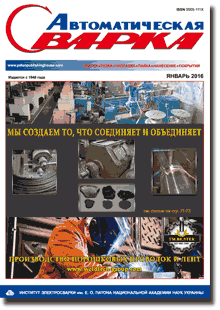| 2016 №01 (04) |
DOI of Article 10.15407/as2016.01.05 |
2016 №01 (06) |

Avtomaticheskaya Svarka (Automatic Welding), #1, 2016, pp. 38-41
Investigation of conditions for providing low content of diffusion hydrogen in welding using electrodes of basic type
A.P. Paltsevich
E.O. Paton Electric Welding Institute, NASU 11 Kazimir Malevich Str., 03680, Kiev, Ukraine. E-mail: office@paton.kiev.ua
Abstract
In this work the mechanisms for prevention of hydrogen absorption at the participation of CaF2 and SiO2 in submerged arc welding and welding with covered electrodes resulting in formation of HF, based on thermodynamic calculations, are considered. The formation of SiF4 and HF was experimentally established in the air samples in the arc zone. In the opinion of researchers, HF is a thermally resistant compound in the arc gap and, thus, it facilitates the decrease of PH in the arc zone. As the criterion for the efficiency of this mechanism the reduction and elimination of weld porosity in submerged arc welding were served. The further works and accurate data on thermal properties of HF, H2, H2O, N2 and other gases at high temperatures, as well as the results of experiments with measurement of [H]diff content in welds showed that the above-mentioned mechanism does not provide the ultra-low [H]diff content. In the present work the investigations on the influence of CaF2 and moisture content in the coating on [H]diff content were carried out, the content of water impurities was determined in the components of electrode coatings at heating up to 1000 °C. It is shown that the preliminary heat treatment of the components provides reduction of the level of [H]diff to ≤3–2 ml/100 g depending on the coating composition. 19 Ref., 3 Tables, 5 Figures.
Keywords: arc welding, covered electrodes, potential hydrogen, diffusion hydrogen, silicon fluoride, hydrogen fluoride, dissociation of gases, components of electrode coatings, chromatographic analysis of hydrogen, investigations
Received: 29.12.15
Published: 15.03.16
References
- Betekhtin, A.G. (1950) Mineralogy. Moscow: Gosgeologoizdat.
- Lushkov, N.A., Razduj, F.I., Shpejzman, V.M. (1959) Hydrogen in welds and its prevention. Leningrad: Sudpromgiz.
- Pokhodnya, I.K., Gorpenyuk, V.N., Milichenko, S.S. et al. (1990) Metallurgy of arc welding. Processes in arc and melting of electrode. Ed. by I.K. Pokhodnya. Kiev: Naukova Dumka.
- Kirdo, I.V., Podgaetsky, V.V. (1949) On effect of fluxes on automatic weld porosity caused by rust. Trudy po Avtomatich. Svarke pod Flyusom, 6, 36–62.
- Frumin, I.I. (1956) Pores prevention in welding and submerged arc surfacing. Svarka, 6, 1–30.
- Pokhodnya, I.K., Shvachko, V.I., Ustinov, V.G. et al. (1972) Mass-spectrometric analyses of gaseous fluorides evolving in arc welding. Ibid., 6, 10–12.
- Pokhodnya, I.K., Shvachko, V.I. (1981) Formation of hydrogen fluoride in arc discharge. Ibid., 2, 11–13.
- Pokhodnya, I.K., Shvachko, V.I., Utkin, S.V. (1998) Calculated evaluation of hydrogen behavior in arc discharge. Ibid., 9, 4–7, 11.
- (1964) Reference book of chemist. 3. Moscow; Leningrad: Khimiya.
- Gurvich, L.V. (1974) Energy of breaking of chemical bonds. Ionization potentials and electron affinity. Moscow: Nauka.
- Gerasimov, Ya.I., Dreving, V.P., Eremin, E.N. et al. (1966) Physical chemistry. Moscow: Khimiya.
- Lakomsky, V.I. (1998) Phenomenological theory of diatomic gases sorption of metal from electric arc plasma. In: Actual materials science of 21st century. Kyiv: Naukova Dumka.
- Pentegov, I.V. (2004) Generalization of formula of K.K. Khrenov for determination of temperature of welding arc plasma. The Paton Welding J., 8, 48–50.
- Zameryakin, L.K., Galaktionov, A.T. (1967) CO2-shielded electric arc welding. Svarka, 6, 74–75.
- Pokhodnya, I.K., Yurlov, B.V., Shvachko, V.I. et al. (1990) Effect of gaseous fluorides on hydrogen content in welds made by high-efficient electrodes with basic type coating. Ibid., 11, 1–6.
- Demchenko, E.L., Snisar, V.V., Lipodaev, V.N. et al. (1991) Ways of hydrogen content decrease in weld metal of 03Kh12N8M2GST type in arc welding. Ibid., 10, 23–27.
- Kuzmenko, V.G. (1980) Peculiarities of reaction of interaction between calcium and silica at 800–1900 o Ibid., 6, 33–35.
- Paltsevich, A.P. (1999) Chromatographic method for determination of hydrogen content in components of electrode coatings. Ibid., 6, 46–48.
- Pokhodnya, I.K., Yavdoshchin, I.R., Paltsevich, A.P. et al. (2004) Metallurgy of arc welding. Interaction of metals with gases. by I.K. Pokhodnya. Kiev: Naukova Dumka.
The cost of subscription/purchase order journals or individual articles
| Journal/Currency | Annual Set | 1 issue printed |
1 issue |
one article |
| TPWJ/USD | 384 $ | 32 $ | 26 $ | 13 $ |
| TPWJ/EUR | 348 € | 29 € | 24 € | 12 € |
| TPWJ/UAH | 7200 UAH | 600 UAH | 600 UAH | 280 UAH |
| AS/UAH | 1800 UAH | 300 UAH | 300 UAH | 150 UAH |
| AS/USD | 192 $ | 32 $ | 26 $ | 13 $ |
| AS/EUR | 180 € | 30 € | 25 € | 12 € |
| SEM/UAH | 1200 UAH | 300 UAH | 300 UAH | 150 UAH |
| SEM/USD | 128 $ | 32 $ | 26 $ | 13 $ |
| SEM/EUR | 120 € | 30 € | 25 € | 12 € |
| TDNK/UAH | 1200 UAH | 300 UAH | 300 UAH | 150 UAH |
| TDNK/USD | 128 $ | 32 $ | 26 $ | 13 $ |
| TDNK/EUR | 120 € | 30 € | 25 € | 15 € |
AS = «Automatic Welding» - 6 issues per year;
TPWJ = «PATON WELDING JOURNAL» - 12 issues per year;
SEM = «Electrometallurgy Today» - 4 issues per year;
TDNK = «Technical Diagnostics and Non-Destructive Testing» - 4 issues per year.





